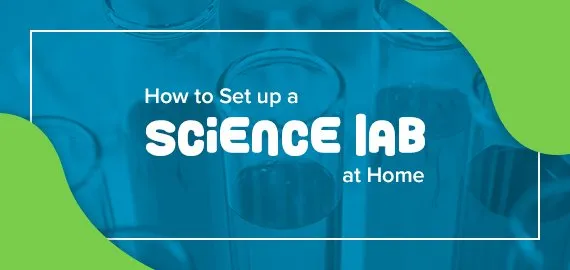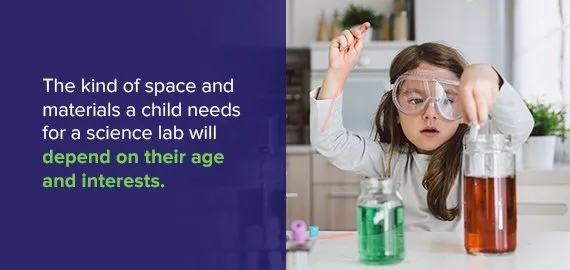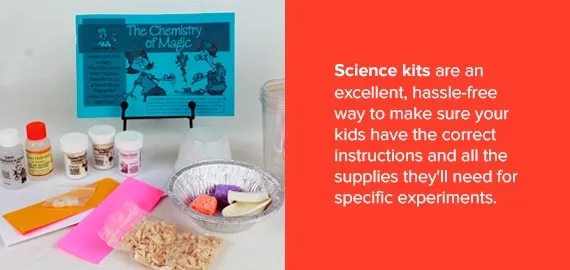What’s the best way to keep kids busy, learning and having fun while social distancing? Make them a science lab at home!
Many kids might be bored staying at home during COVID-19, but a science lab will open up a world of possibilities to them. From creating a chemical reaction to engineering a paper glider, experimenting with science is fun and educational. Use this extra time indoors to encourage your child’s curiosity and passion for science.
The best part about a DIY science lab at home for kids is that it doesn’t take much — just a little counter space, a chair and some creativity.
How To Make a Science Lab at Home
Follow our simple guidelines on how to make a science lab at home, and your kid will be experimenting in no time.
How Interested Is Your Child in Science?
Before building a kids’ science lab at home, it’s essential to account for your children’s ages and their interest in science. A science lab for a middle schooler will look much different from one built for a child entering elementary school. The kind of space and materials a child needs for a science lab will depend on their age and interests.
Whereas an older child might be competent enough to handle ingredients and cleaning up messes on their own, a younger child might need a science lab set up in an area where you can frequently check up on them. Of course, you won’t be able to always be hovering near the science lab, so make sure to put it in a space that you feel comfortable leaving your kids alone in for short periods, no matter their ages.
What kind of science your kid is interested in will also affect the science lab’s placement. For example, if your kids like messier science experiments like chemical reactions, make sure to set up their lab near a sink. Overall, make sure to construct your science lab at home specifically for the kids who will be using it.
How Much Space Do You Have?
Once you’ve decided what kind of science your lab needs to be able to handle, you’ll need to consider which area of your house will best accommodate a science lab for kids, and how much space you have to fit one. Luckily, science labs don’t require much space if well organized, so that spare corner you have in the basement, office or playroom could be perfect.
Here are some crucial aspects to consider when you make your science lab.
Science Table
A reliable science table is the central component of any science lab — it’s where the magic happens! Your science table doesn’t need to be fancy. Any desk or folding table will do, as long as there’s enough space for all the science your kid wants to explore.
The pivotal thing to remember when setting up your kid’s science table is to put it in an area that you don’t mind getting messy. As a natural part of learning, mistakes are inevitable. So, to promote learning and being unafraid to fail, make sure your science table is far away from valuable, fragile or expensive items.
Storage Space
Ensure there’s enough shelving or bins near your science table to hold all the supplies your kids will need for their experiments. If any of the ingredients included in the experiments are hazardous, store them appropriately in a safe area.
Lighting
Experimenting in a poorly lit area can be dangerous, so it’s essential to locate your lab in a well-lit space. Try to station your science lab near a window or purchase a table lamp for the area if it’s difficult to see with the overhead lighting alone.
Ventilation
For experiments that involve smelly substances or harmful fumes, you’ll want the room your kid’s science lab is in to have appropriate air circulation. Again, setting up your science lab near a window can be beneficial by providing an easy way to ensure good ventilation.
Flooring
Set your science table up on a floor that can handle spills. Flooring materials like vinyl or linoleum are easy to clean up. If you don’t have a good flooring option, make sure your child puts down newspaper before each experiment.
Recommended Materials and Equipment
After you’ve set up your science lab, you’ll need to fill it with the right materials and equipment to use it. That doesn’t have to mean buying an expensive microscope. Instead, work with the magnifying glass you already have and get creative in finding experiments that don’t involve advanced ingredients or equipment.
Let’s explore what materials you need to keep around to make sure your home science lab is safe and fully functional.
Safety Gear
When using their science lab, safety should always be your children’s top priority. Make sure your kids wear the right protective equipment to keep them and their clothes from harm while experimenting.
Here’s the science safety gear you should always have on hand:
- Safety goggles
- Lab coat or smock
- Gloves
Basic Experiment Supplies
To conduct experiments, your kid will need some fundamental supplies — and, because cooking is chemistry, you most likely already have a few science-related ingredients in your cupboards.
Check your pantry for these science items:
- Salt
- Baking soda
- Vinegar
- Oil
- Food coloring
- Cornstarch
- Fizzing tablets
- Water
Science, technology, engineering and math (STEM) experiments frequently use other household materials. Encouraging your child to build models out of miscellaneous scraps is also a great way to recycle.
Gather up these STEM materials and add them to your lab supplies:
- Paper clips
- Balloons
- Toothpicks
- Straws
- Tape
- Yarn
- Ruler
- Scissors
How to Use Your Science Lab
Now that you have a well-stocked science lab, it’s time to use it! You can find an abundance of printable kid-friendly science experiment ideas online to get started.
If you don’t know where to begin, here are a few of our favorite project ideas:
Science kits are an excellent, hassle-free way to make sure your kids have the correct instructions and all the supplies they’ll need for specific experiments. By purchasing a science kit subscription , you’ll be able to provide your kids with a steady supply of fun, educational and safe science experiments without having to worry about coming up with ideas yourself or going out to buy new supplies every week.
Make Learning Fun With Science Explorers
When learning is fun, your child will want to do more of it. So let Science Explorers show them how enjoyable learning can be! Put your new home science lab to good use by signing up for a virtual summer STEM camp with us. We offer virtual science summer camps over a range of topics , so every kid can find a program they’re interested in.
And the fun doesn’t have to stop after summer. Sign up for an after-school STEM club with Science Explorers to keep the fun educational activities coming. If you have a budding scientist at home, check out all the cool programs Science Explorers has to offer today.



